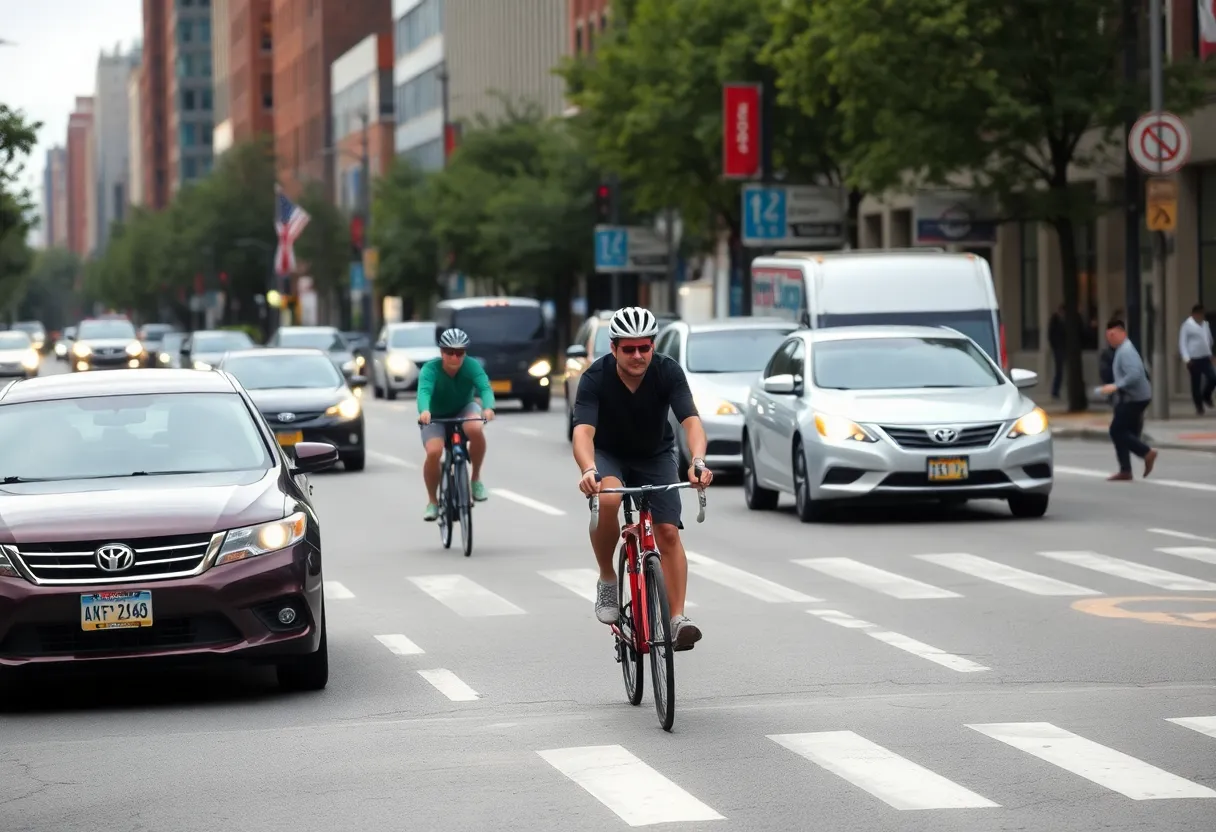Boston, September 2, 2025
News Summary
As the Boston mayoral election approaches, the debate surrounding the city’s bike lanes has intensified. Opponents argue for limits on bike infrastructure, while supporters highlight safety and mobility benefits. With polling showing divided opinions, the city is reviewing bike infrastructure and plans to enhance community engagement in future projects. The importance of safe cycling infrastructure is underscored by recent incidents, emphasizing the need for better protections for cyclists and improved pedestrian safety measures.
Boston
Debate over bike lanes in Boston has intensified as the mayoral election approaches, centering on safety, traffic impacts, community engagement and city planning. Opponents are calling for limits on bike infrastructure on major corridors, while supporters and safety advocates argue that expanded bike lanes can reduce injuries and shift travel patterns. The dispute has prompted a city review, public polling showing divided opinion, and renewed promises from city officials to revisit pedestrian and cycling safety measures.
Top developments
Immediate conflict: A vocal opponent has urged that major highways and parkways remain without bike lanes, arguing such corridors should be bike-free. Supporters and transportation advocates counter that many Boston streets function as neighborhood main streets and require protected space for vulnerable road users.
Mayor’s actions and political stakes: The mayor has implemented approximately 15 miles of new bike lanes at an estimated cost of $2.25 million. These projects have become a focal point in the mayoral campaign, with opponents framing bike-lane expansion as a policy failure and supporters defending it as part of a broader safety and mobility agenda.
Public sentiment and review: Polling indicates that 48% of Boston voters believe there are too many bike lanes in the city. In response to community concerns, a city review examined bike and bus lane construction processes and concluded that public communication and community feedback were sometimes inadequate. The review recommended establishing ongoing working groups to ensure continuous community input on future projects.
Supporting details: safety, traffic, and evidence
Transportation advocates emphasize that slower vehicle speeds reduce the severity of injuries to cyclists and pedestrians, and that protected bike lanes do not always require removing vehicle travel lanes. City planners note many urban streets were designed historically for pedestrians and slower-moving transport, and that modern curb-separated bike infrastructure can align with those designs.
Analysts cited comparative data from major global cities showing that adding protected bike lanes often leads to higher cycling rates and lower car use. One analysis referenced reductions in average car travel times after lane installation in a large U.S. city, suggesting the potential for improved traffic flow when road space is reallocated and travel behavior shifts.
Critics point to specific design choices, such as the reliance on flexible plastic posts as lane separators, describing these as insufficient physical protection for cyclists. Proponents counter that studies demonstrate a meaningful reduction in collision risk when protected lanes are installed, though the type and robustness of the protection matter.
Human impact and local examples
Safety advocates highlighted the case of a Boston University student who has been struck by vehicles multiple times while biking in the city. This case has been used to underscore the perceived need for safer, better-protected biking infrastructure to reduce repeat incidents and make commuting safer for students and residents.
Business owners along streets where lanes were added report mixed impacts: some express concern about lost curbside parking and altered traffic patterns potentially affecting customers, while others say businesses adapted and customer access was sustained or increased after changes.
City response and next steps
The city has committed to revisiting pedestrian safety measures after residents raised concerns about shortened crossing times at certain intersections. Recommended next steps from the city review include forming dedicated community working groups to guide future lane projects, improving outreach and transparency during planning, and re-evaluating design standards for lane separators and crossing timing to enhance safety for all users.
Political context
Opposition to bike lanes is increasingly politicized ahead of the mayoral election, with opponents using public discontent to press for policy reversals and supporters framing lanes as part of a long-term vision for safer, multimodal streets. The debate is shaping campaign conversations and may influence near-term transportation decisions.
What this means for residents
Residents can expect heightened public meetings, possible adjustments to lane designs, and efforts by city officials to solicit continuous community input through proposed working groups. Changes to crossing times, reconsideration of barrier types, and targeted communication about planned projects are likely to appear in the coming months.
FAQ
What are the main arguments for and against bike lanes in Boston?
Supporters cite improved safety for cyclists and pedestrians, reduced vehicle speeds, and evidence from other cities showing increased cycling and often decreased car use. Opponents point to potential traffic impacts, lost parking for businesses, perceived insufficient community engagement during planning, and concerns about the adequacy of physical protections like flexible posts.
How much has the city spent on recent bike lanes?
The city has implemented roughly 15 miles of new bike lanes at an estimated cost of $2.25 million.
Are bike lanes proven to reduce injuries?
Studies indicate that protected bike lanes can reduce collision risks and the severity of injuries by separating cyclists from faster-moving traffic and encouraging lower vehicle speeds. Effectiveness depends on design quality and protective elements used.
Will bike lanes increase traffic congestion?
Evidence from some cities shows that well-planned bike lanes can shift travel modes and sometimes shorten car travel times after adjustments. Outcomes vary based on local conditions, project design, and complementary measures such as traffic signal timing and parking management.
How is the city responding to community concerns?
The city review recommended better public communication and the formation of working groups to provide ongoing community input. Officials have also pledged to revisit pedestrian crossing times and other safety measures where concerns were raised.
How can residents get involved?
Residents are encouraged to participate in public meetings, join proposed working groups when announced, and submit feedback during planning periods for street projects.
Quick reference table
| Topic | Detail |
|---|---|
| New bike lane mileage | Approximately 15 miles |
| Estimated cost | $2.25 million |
| Public opinion | 48% of voters say there are too many bike lanes |
| Key safety concern | Pedestrian crossing times and protection for cyclists |
| City review recommendations | Form working groups, improve outreach, reassess barrier types |
| Next steps | Enhanced community engagement and potential design revisions |
Deeper Dive: News & Info About This Topic
HERE Resources
Mass Hole Donuts Faces Uncertain Future Amid Bike Lane Plans
Somerville Approves Designated Bike Lanes on Broadway
Museum of Science and MassDOT Plan Car-Free Connection Over Charles River
Pedestrian Critically Injured in E-Bike Accident in Boston
Cambridge Emerges as a Leading City for Cycling in the U.S.
Michelle Wu Maintains Strong Lead in Boston Mayoral Race
Symposium Celebrates Boston’s Folk Revival Era
Boston’s Sidewalk Crisis: $800 Million Repair Backlog
Boston Mayoral Election: Wu vs. Kraft
New South Coast Rail Service Enhances Fall River Transport
Additional Resources
- Boston Globe: Letters to the Editor on Bike Lane
- Boston Magazine: Bike Lanes Battle in Boston
- NBC Boston: Bike Lanes & Pedestrian Safety
- Cambridge Day: The Nonlinear Path of Biking in Boston
- Wikipedia: Bicycle Infrastructure
- Encyclopedia Britannica: Bicycle

Author: STAFF HERE BOSTON WRITER
The BOSTON STAFF WRITER represents the experienced team at HEREBoston.com, your go-to source for actionable local news and information in Boston, Suffolk County, and beyond. Specializing in "news you can use," we cover essential topics like product reviews for personal and business needs, local business directories, politics, real estate trends, neighborhood insights, and state news affecting the area—with deep expertise drawn from years of dedicated reporting and strong community input, including local press releases and business updates. We deliver top reporting on high-value events such as Boston Marathon, Head of the Charles Regatta, and Boston Harborfest. Our coverage extends to key organizations like the Greater Boston Chamber of Commerce and Associated Industries of Massachusetts, plus leading businesses in finance, biotech, and insurance that power the local economy such as Fidelity Investments, Biogen, and Liberty Mutual Insurance. As part of the broader HERE network, we provide comprehensive, credible insights into Massachusetts's dynamic landscape.





